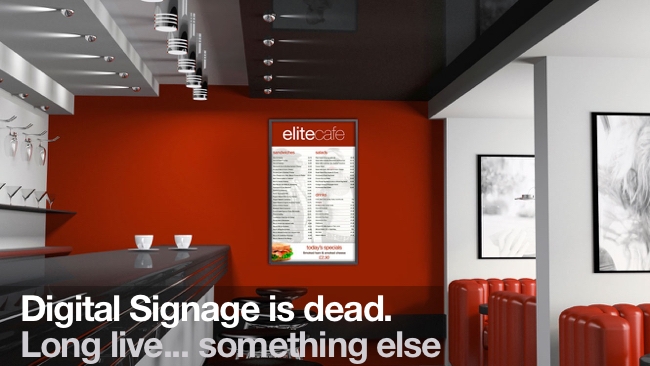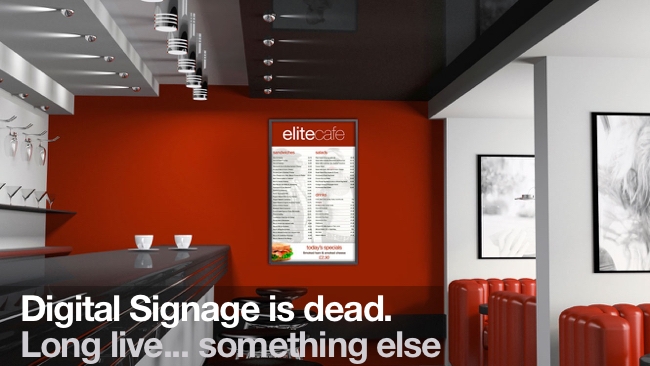
 Digital signage is dead?
Digital signage is dead?
We take a look at the digital signage industry and the reasons why it has progressed differently than many of its advocates, including us, had envisaged.
Digital signage has now split between digital posters and close-up signage (with mobile in the middle). 4K is ideal for close up work.
As little as eight years ago, digital signage was posited enthusiastically as the 'next big thing' in marketing. Even by me.
For a while, I was the CTO at a digital advertising technology company. From our perspective then, digital signage was poised to be the most lucrative - and most effective - marketing medium ever. We were wrong about that. But from today's viewpoint, it's fascinating to see how the digital signage market has fragmented, because it tells us a lot about where we are now and how we got here.
What hasn't changed from our vision then is that marketing is all about communication and connections. What has changed is mobile devices and social media.
Smartphones and social media are so pervasive today (with over a billion people using Facebook EVERY DAY!) that it's a struggle to think back eight years when technology looked like it was heading in other directions.
Attitudes have changed, too. The vision back then was that, very soon, every available surface would show video and that video would be personally selected for you. We had probably watched Minority Report a few too many times, but technically, there's nothing to stop this happening - sooner, rather than later.
The counterargument
But this is why it isn't going to happen. Not just yet, anyway. It's because, increasingly, we don't like advertising in our faces. This type of full-on outdoor advertising has its place, in Times Square or Piccadilly Circus, perhaps, but not in our high streets and taxis. (Some companies have yet to get this message. I've just been in a New York Taxi from JFK to Manhattan. The wonderful New York Skyline was completely obscured by a video screen approximately twelve inches from my face, showing advertising loops and blasting audio loudly into the already noisy vehicle).
In 2008, the vision was that we'd use our phones to interact with giant screens in shopping malls and public venues to willingly take part in promotional activity. We'd be enticed into shops by special offers, just for us, just at that time.
With hindsight, it's easy to see why this wasn't going to happen.
First of all, it's too intrusive. While we seem quite happy to sleepwalk into ever diminishing civil liberties on the back of anti-terrorism measures (have you tried shooting footage in a major city lately?), we do seem to object to marketers having and using data about us. Quite rightly, too. Occasionally, driving around in a city, I see requests for a Bluetooth connection from an interactive kiosk or screen bursting onto my car's central touchscreen. That form of interactivity was never going to work. It's too annoying, too disruptive and too intrusive. Most of all, it offers too little in exchange for the fiddly process of Bluetooth paring to make it work.
And it doesn't need to. Today, digital signage has fragmented, and is better for it. Instead we have:
Digital billboards
These are literal and direct replacements for paper-based billboards. They're still expensive - so you don't see them everywhere - but they have big advantages for advertisers. You can change adverts with zero effort and rotate multiple adverts in the same space. The metrics, as I remember them, were that you can make as much as six times the revenue from a digital billboard as from an 'analogue' one.
There are downsides. Not only are they very expensive to buy, but they consume a lot of electricity, especially in sunny climates. LEDs are a lot more efficient now than ten years ago, but you can't hide the fact that a screen that's brighter than reflected sunlight is expensive to run and not exactly friendly to the planet. (You could balance this against carbon footprint of running a fleet of trucks to service the needs of 'analog' billboards and, of course, you could source renewable energy to feed the digital ones).
Digital posters
Digital posters are smaller and you stand closer to them. They're normally conventional LCD video screens, albeit brighter and bigger. You'll find them in shopping malls, but also in museums, galleries or anywhere you'd normally expect to find detailed information about products or services.
HD transformed the landscape for digital posters. 4K is going to go even further. It is, I have to say, an absolute joy to see well-designed content at these resolutions.
Feature screens
Ever been to Las Vegas? Then you've seen feature screens. These are gigantic LED screens that are designed to be part of the landscape and architecture. They can be any shape or size and always carry highly bespoke content. They're expensive, but you couldn't have modern Las Vegas without them. You see them in other places too, but the companies that sell them almost always take their clients to Vegas to showcase them.
Incidentally, the vast majority of feature screens in Las Vegas are made by one company: YesCo. Or at least, they were, until YesCo was taken over by Samsung, fairly recently.
Smartphones and Social media
These two go together. They don't have big screens and they don't adorn the sides of buildings. But they provide the fabric that integrates modern digital marketing. Digital Signage plays a part in this, but the story, as envisaged eight years ago, has stood on its head. Instead of digital signage using phones as controllers for outdoor interactivity, now campaigns take place on social media and phones, and might themselves be advertised on outdoor media.
Modern advertising is, in any case, moving from 'in your face' promotions towards content marketing, where companies that wish to promote their products create articles and videos that are useful and informative. Conventional advertising will always have its place, but that place will not always necessarily be on the side of a building.
Tags: Business


Comments